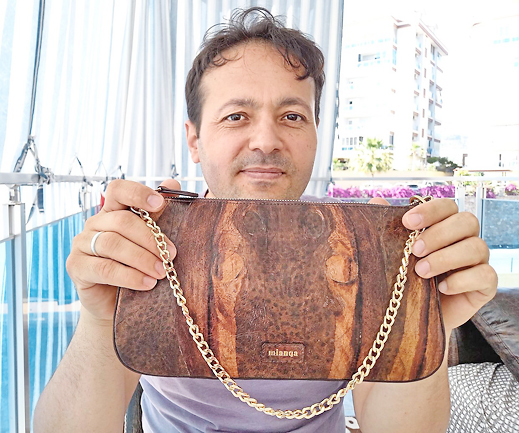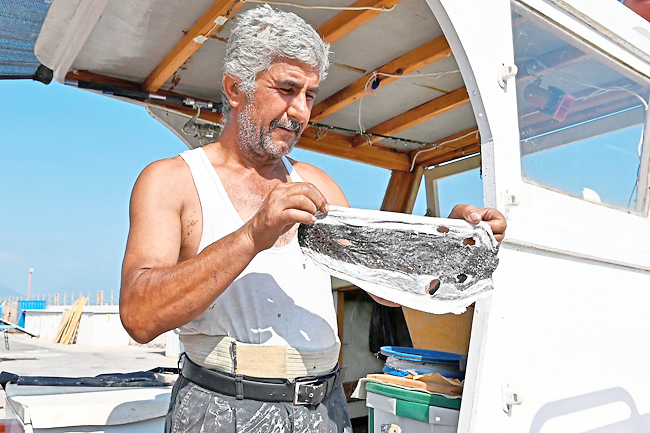THE STAR – Mehmet Ozata lays out his colourful collection of leather products, from purses to key rings, all made from the skin of puffer fish, an invasive species that has been terrorising the Turkish coast for decades.
An engineer in Alanya, near Antalya, Ozata has been working with local universities to create a sustainable leather made from the skins of puffer fish.
While his project is still at an early stage and output depends on the size of local catches, his products are attracting interest from Russia to the Middle East, Ozata said. Plus, they are raising awareness of the problem.
Native to the Indo-West Pacific, the puffer fish has been destroying local fish populations in the Mediterranean for almost two decades.
Too toxic to eat, silver-cheeked toadfish can grow up to a metre in length and weigh some seven kilogrammes. The fish reproduce faster than any predators able to hunt them.
They first came to the Mediterranean after the Suez Canal opened in the 19th Century.
Mehmet Ozata lays out his colourful collection of leather products, from purses to key rings, all made from the skin of puffer fish, an invasive species that has been terrorising the Turkish coast for decades.


An engineer in Alanya, near Antalya, Ozata has been working with local universities to create a sustainable leather made from the skins of puffer fish.
While his project is still at an early stage and output depends on the size of local catches, his products are attracting interest from Russia to the Middle East, Ozata said. Plus, they are raising awareness of the problem.
Native to the Indo-West Pacific, the puffer fish has been destroying local fish populations in the Mediterranean for almost two decades.
Too toxic to eat, silver-cheeked toadfish can grow up to a metre in length and weigh some seven kilogramme.
The fish reproduce faster than any predators able to hunt them. They first came to the Mediterranean after the Suez Canal opened in the 19th Century.
Those who make their living from fishing say they are forced to replace their nets every few months.
The Turkish government has been trying to encourage people to catch the invaders, offering a bounty of TKL12.5 (MYR3) for each fish.
That is not enough, said fisherman Mehmet Gokmen, 55, who has been casting his nets off Alanya for 40 years. The money isn’t worth the effort, he told dpa while sitting in his boat.
“It is such a curse, they hunt like piranhas… Some friends consider leaving the business,” said Mahmut, another fisherman.
The currency crisis, rising cost of living and soaring energy prices also weigh heavily on fishing businesses. Most are family run and many are now struggling to maintain their boats.
Additionally, “stocks in Turkiye aren’t managed very well and fishing is not regulated effectively, which means losses for fishermen”, Ekin Akoglu from the Middle East Technical University in Ankara said.
Akoglu said a bonus system alone cannot contain the invasion, citing Cyprus, where higher sums on offer have failed to dent the problem over the past 10 years.
He said it would be better to tackle the issue by commercialising use of the fish, by making their skins into leather or using them in a medical setting, for example.
A university in İskenderun, some 530 kilometres east of Alanya, has been looking into ways to make the teeth of puffer fish into fillings and crowns for dentistry, according to local media.
Ever since he read about a child whose finger had to be amputated after a puffer fish bite, entrepreneur Ozata had wanted to help.
He offers local fishermen like Gokmen TKL20 for catching one fish. It then takes eight hours to process the skin into leather. Next, Ozata works with local women to create the hand-made accessories.
They need around seven fish skins, depending on their size, to make one handbag for example. They discard the remains of the fish as they are poisonous.
With three helpers, fisherman Gokmen says he can catch around 100 puffer fish in the space of an hour.
He has been pulling the puffer fish out of the water for the past two decades, he said.
The leather is stronger than other leathers and the distinctive pattern of the fish skin is visible in the products, making it more attractive for buyers, Ozata said.
His programme is small scale but ambitious.
“With the right investor and an effective social campaign, I am sure we can finally help mitigate this problem in a couple of years,” he said.






